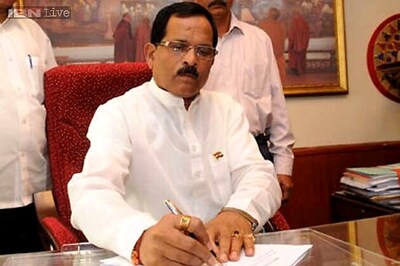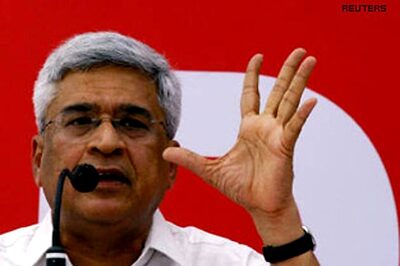
views
Chennai marooned, Bangalore a garbage dump, Delhi stinking ? a multitude of infrastructural problems have struck the cities of India that the people are bravely trying to cope with.
While Bangalore has been bearing the brunt of fast paced urbanisation, Chennai has turned into a virtual lake and Delhi's become a victim of pollution.
With the administration turning a blind eye to the mounting problems, the people living in these cities and socially active organisations have decided they are not going to sit back and watch life around them deteriorate.
Chennai: Lake or city?
Chennai has been more lake than city for the past two months and while systems aren't coping, the people are. Friendly fishermen are helping out flood-hit residents in parts of Chennai.
Madipakkam, a village in Chennai, has been flooded over for three weeks now but the bad weather has not brought foul temper to the residents.
The reason for this has been a group of boatmen from a small fishing village called Chinna Neelankarai, who are rescuing people in distress.
No one called for the fishermen and the municipality certainly does not pay them or feed them. However, the 20 fishermen have brought their own catamarans to rescue people from their flooded homes.
Ramachandran, a fisherman who is a part of the 'rescue team' says that they are just repaying their debt.
PAGE_BREAK
"We haven't forgotten how the people of Madipakkam helped us when we were suffering after the tsunami. It's time for us to repay their kindness," says he.
Every extra day that they stay in Madipakkam, these fishermen are losing nearly Rs 500 of their income. But they think it's a small price to pay.
Fisherman Sudhakar says, "Just look at this place. These people are suffering. How can we not help?"
As indiscriminate encroachments and garbage dumping increase around the lake and make water drainage impossible, excess water has nowhere to go.
An administration that turned the other way when the encroachments happened has now no one blame but itself.
Government deployed coast guard boats come and go in the blink of an eye. If it weren't for these boatmen, people in Madipakkam would have been stuck in their flooded homes for weeks.
For these people whose homes have been flooded for the fourth time this year, help, fortunately, is just a boat ride away.
Bangalore: Garden city to garbage city
Bangalore is bursting at the seams and it's not just due to a faulty infrastructure system.
Indiscriminate felling of trees, air and noise pollution and garbage overflowing - these are just some of the environmental concerns that Bangalore faces today.
PAGE_BREAK
A non-Government organisation called the Centre for Sustainable Development (CSD) has issued a 65-page booklet called the Environment Report Card for Bangalore.
The report card gives the city ?positive or negative marks' depending on how it scores in various departments.
Director, CSD, Dr A Ravindra, says, "There are both pluses and minuses in the city. When we conducted our survey, we realised that Bangalore?s water facilities and sewerage system worked well."
"However things like roads and the drainage systems scored low as did the sheer number of vehicles on the roads that cause management problems in the city," he adds.
The making of the Report Card involved interviewing a cross section of citizens, field surveys and data collection from concerned departments.
But the report does not just enumerate the negative and positive points of the city.
It gives suggestions on how to improve the city's environment, repair and clean storm drains, reduce air and noise pollution, build a sanitary landfill near the city and prevent wastage and misuse of water.
Director CSD, Dr A Ravindran, says, "The objectives of the report are to track the changes over a period of time. The aim is to make Bangalore breathe easy again."
Delhi: Riverside woe
A boat ride on the river Yamuna in the mountains would be something people would sit back and enjoy.
Unfortunately in Delhi, the experience is far from enjoyable and the stench of the river would drive away the most enthusiastic of sailors.
PAGE_BREAK
On International Volunteers Day, a group of true blue or rather true green volunteers braved the unpleasant odour, rolled up their sleeves and pitched in to clean the muck of the River Yamuna.
A few hundred children, including those with special needs gathered here with the aim to make a statement.
A student of Sri Ram School, Rahul, says, "Religion has played the biggest role in making Yamuna as murky as it is. People throw garlands in the river and ashes of the relatives that have died, in the river as a mark of religious respect. What they don?t realise is that they are polluting the river."
The government has spent over Rs 1000 crore in an effort to clean up the river but most of it has been in vain.
Co-ordinator, We for Change Foundation, Vimlendu Jha, says, "The Yamuna is no longer a river, it has turned into a drain. 70 per cent of Delhi has never seen or touched the water of the river and so don?t know what is actually wrong with the river. It is probably the only river that has methane coming out of it."
The energy, the spirit and the camaraderie between these children from different walks of life has managed to make a difference and turned an otherwise unpleasant task into an interesting mission.
However, the river needs not just activists to steer the cleanliness drive but also an active government, willing to fund the anti-pollution Yamuna campaign and citizens who are aware of the importance of a clean environment.
(Priyanjana Dutta in Bangalore; Rohini Mohan in Chennai and Shalini Siromani in Delhi )




















Comments
0 comment